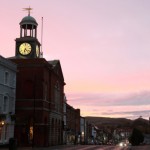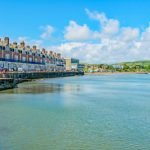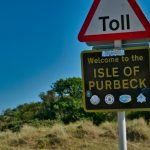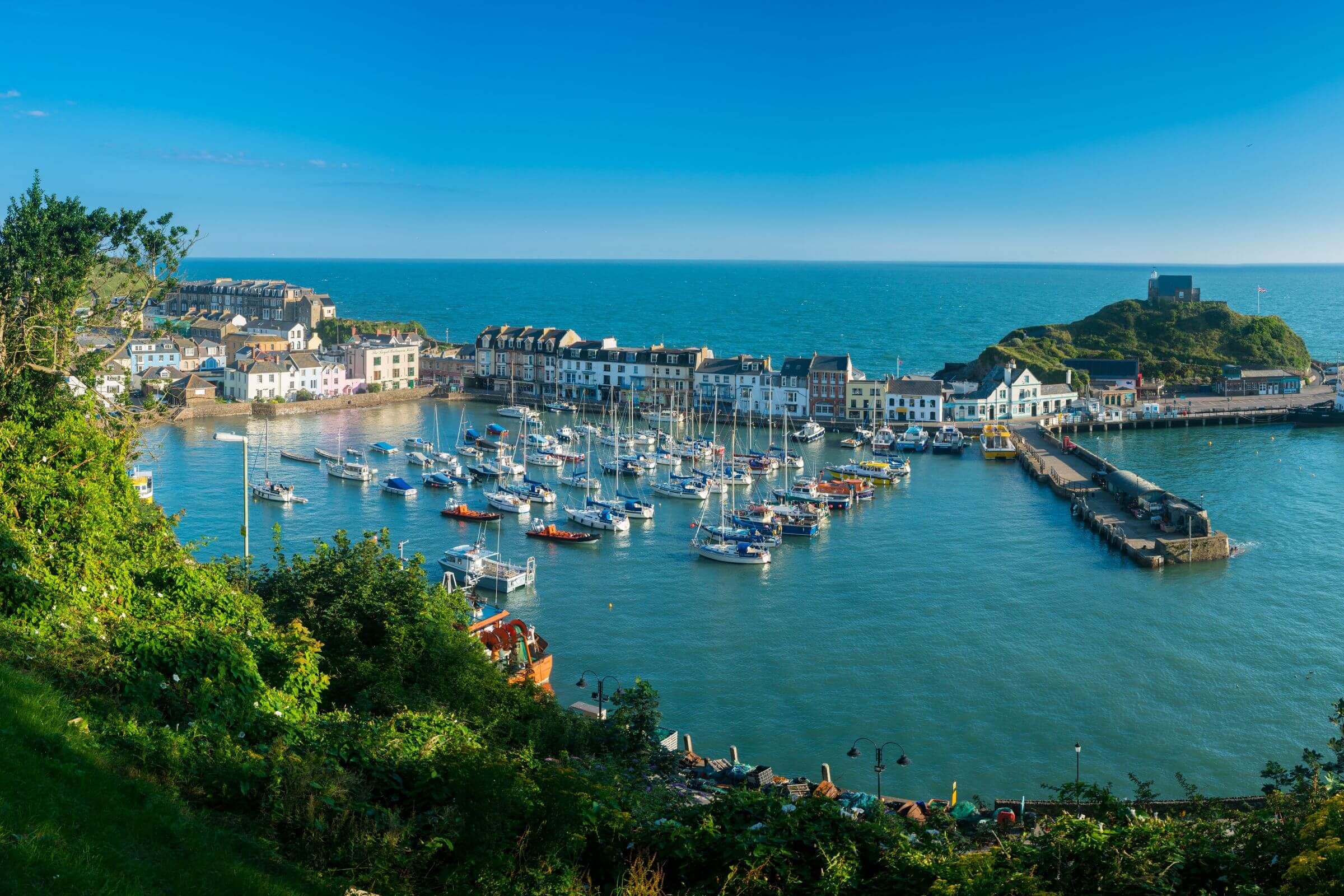
A quick guide to Ilfracombe
Ilfracombe is a town, seaport, seaside resort and civil parish on the North Devon coast in southwest England. The town’s small harbour is dominated by the massive slate cliffs that surround it. The ancient dockland area is now noted for being the site of ‘Verity’, a 66 ft (20 m) high sculptor by world-famous artist Damien Hirst, which was erected in October 2012. The town lies approximately 12 miles (20 km) north of Barnstaple and 28 miles (45 km) west of Minehead at the mouth of the Bristol Channel. The recorded population of Ilfracombe at 2011 national census was 11,509.
A Fleeting History
Ilfracombe was first settled in the Iron Age when the Celts established a hill fort at Hillsborough, high ground that overlooks the harbour. In 1086, the Domesday Book recorded the settlement’s place name as Alfrincombe, and that a manor house already existed at Chambercombe, built by Norman knight Champernon. The place-name ‘Alfreinscoma’ is derived from Anglo-Saxon, translating as the “Valley of the sons of Alfred”. As time passed, the settlement’s name transmuted to Ilfridscombe, then Ilfordcombe and finally to its present-day name of Ilfracombe.
By the 12th century, Ilfracombe comprised of two distinct communities; a farming community, established around the parish church, and a fishing community, that had formed around the natural harbour. Lands around the church were part of the estate owned by Champernowne family, while those by the harbour belonged to the Bouchier family, who held the manor at Bath. Because of Ilfracombe’s strategic location on the Bristol Channel, and its outstanding natural harbour, it soon developed to become a significant port. At the beginning of the 13th century, mining began 5 miles away at Combe Martin. In 1292, it was recorded that some 4 tonnes of lead and silver ore was being smelted from workings at Combe Martin, obviously contributing to local wealth.
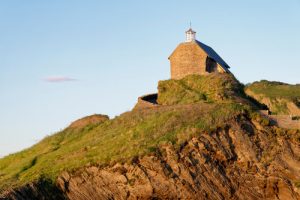
St Nicholas Chapel – built in 1361, is the UK’s oldest working lighthouse
In 1208, the new stone church of the Holy Trinity was built in Ilfracombe to replace the earlier Saxon one built of timber. Also, in 1208, Ilfracombe is recorded as having provided King John with ships and men for his invasion of Ireland. In 1247, it supplied a ship to aid Scottish King Alexander for the capture of the Western Isles from the Norse.
In 1278, the town was granted permission to hold a weekly market. In 1347, as an indication of its growing significance, Ilfracombe sent 6 ships and almost 100 men to aid Edward III’s Siege of Calais. In 1361, the UK’s oldest working lighthouse, known as St Nicholas’s Chapel, was built on Lantern Hill. In 1418, Ilfracombe was granted the right to raise money to fortify the town. A new stone tower was built on either side of the port and the town was enclosed with stone walls but nothing now remains of ‘Ilfracombe Castle’. However, several local place names; Castle Hill, Castle Terrace and Warfield, uphold the remembrance that a castle did once exist in the area.
Up until the early 15th century, the local manor ‘Chambercombe’ had remained in the possession of the Champernons’, up until such times that the last family member died without an heir. It then quickly passed through the Polglass, Herles, and Bonville families to the Greys. Although ownership of property seemingly passed to the crown around 1450, the Grey family seem to have retained the tenancy. In 1553, the Lord of the Manor at Chambercombe, was Henry Grey, Duke of Suffolk and father of the luckless Lady Jane Grey. Lady Jane supposedly stayed at Chambercombe Manor, shortly before her 9-day reign on the throne of England in July 1553. On 12th February 1554, Lady Jane, just 17 years old was executed for high treason along with her husband and father.
Ilfracombe’s importance continued throughout the rest of the 16th century. In 1582, Ilfracombe was the only town in North Devon that provided a ship (80 tons) in response to Elizabeth I request for support to bolster the navy. In 1585, Ilfracombe also provided provisions and shipping to transport 800 troops to quell the rebellion led by the Earl of Tyrone in Ireland.
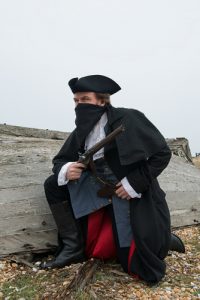
Smuggling was rife in the 18th & 19th centuries
In 1642, at the outbreak of the English Civil War, Ilfracombe, like most seaports, supported Parliament. In August 1644, Sir Francis Doddington, led a Royalist march on the town from Minehead, in an attempted to seize Ilfracombe Castle. The assault ultimately failed, but not before 27 houses were burnt down and at least 11 inhabitants killed in the retreat from the town. Though, a few weeks later, Ilfracombe Castle surrendered to a second attack led by Doddington, without a shot being fired. However, in April 1646, the town was re-taken for Parliament, by Colonel Sheffield.
From the 1680s onwards, smuggling began to develop around the North Devon coast, when the government imposed particularly high taxes on many imports. By the 18th and early 19th centuries, smuggling had become a way of life in North Devon, with Ilfracombe becoming one of the more favoured landing destinations. Some of the reported smuggling operations were quite considerable. In 1785, a 96-gallon cask of rum was found at Watermouth Cove. And, in 1801, 224 gallons of gin and 164 gallons of brandy were found on the shore near Ilfracombe.
It very much appears that almost the whole of Ilfracombe’s population where involved with smuggling in one way or another. Even Ilfracombe’s pilot boats were high on the list of suspect smuggle craft. One such vessel, ‘the Cornwall’, was seized by the authorities and cut up for scrap. Somewhat embarrassingly, Ilfracombe Levy Collector, Thomas Rudd, was father-in-law to one of the town’s best-known smugglers, William Cooke, who somehow always managed to evade capture. In 1825, the richest man in Combe Martin, John Dovell, was prosecuted for handling smuggled goods.
Far worse than smugglers were ”the wreckers”, who would lure ships onto the rocks with the use of bogus lighting and then pillage any valuables. However, salvage could only be kept if there were no survivors. To this end, local woman, Elizabeth Berry, was rumoured to hold down drowning men with a pitchfork. By the 1850s, ‘wrecking’ had become such a local scandal that Local Rev. Charles Crump, was moved to write an account of the sinking of the schooner, Thomas Crisp, at Morte Point. The upshot was that the authorities agreed to build a lighthouse at Bull Point which was completed in 1872.
In the 1820s, a series of four tunnels were hand-carved through the rock, by Welsh miners, at Ilfracombe. The tunnels were to allow access by horse-drawn carriage to two small secluded beaches, each with its own tidal pool. In Victorian times, segregated bathing of the genders was the order of the day, and while women were subject to a strict dress code, men often swam naked. The tunnels still exist and signposted as ‘Tunnels Beaches’. In 1856, writer Mary Ann Evans, famed under her pen-name George Eliot, accompanied her partner George Henry Lewes to Ilfracombe, when he was researching his book; Seaside Studies, published in 1858.
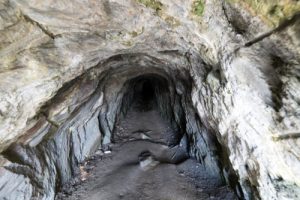
A mid-19th century mining revival at Ilfracombe produced little results
In 1862, the North Devon Silver-Lead Mining Company was formed to exploit the assumed rich ore deposits around Combe Martin. It was widely reported in the press that when Knap Down Pit opened that “employment would be available for hundreds of years to come”. However, the returns from the mine were mediocre at best. Similarly, in 1864, when the New Combmartin Silver-Lead Mining Company reopened the West Challacombe workings, the venture produced very little. In 1876, exploration work began at Harris’ Mine, but after four years of little find, the mine was abandoned and filled-in.
On 28 July 1896, a fire started in the basement of William Cole’s shop on the corner of Portland Street/Fore Street. The local volunteer fire brigade managed to bring it under control by the following morning but not before 35 houses and business premises had been destroyed. The incident, dubbed “The Great Fire of Ilfracombe”, saw damage estimated at £100,000, about £13.4 million at today’s prices (2020).
On the 8th August 1914, a battery of 130 volunteers with the Territorial Force left Ilfracombe for France, with many not returning. In all 157 local men were recorded as being killed during the Great War. Their names are inscribed on Ilfracombe’s 1914 – 1918 War Memorial at Holy Trinty Church.
In June 1931, cafe owner Mr Nat Lewis made an application to the council for permission to rent deck chairs on Hele Beach, the first of its kind. In 1935, an Ilfracombe Guide was published which had the first-ever advert for camping in Hele Bay.
During WW2, Ilfracombe essentially became a garrison town. The Royal Army Pay Corps occupied the whole of the Ilfracombe Hotel and the War Office took over much of the land of the golf course. In 1944, a trial took place for PLUTO (Pipe Line Under The Ocean) between Watermouth and Mumbles in South Wales. PLUTO was the method used to transport fuel across the English Channel to facilitate the D-Day invasion by the allied forces.
The Modern Era
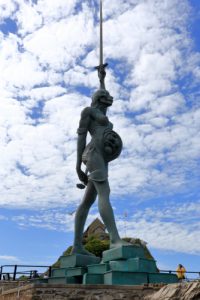
‘Verity’ dominates the town’s harbour area *
After WW2, Ilfracombe began to take off as a tourist destination, firstly being popular with campers. By the early 1960s, static caravan sites began to be set up close to the town. And, by the end of the 1960s, there were holiday flats for let in the town.
Today, Ilfracombe has an established tourist industry and a fairly mixed economy that also includes manufacturing, leisure, retail and the service sector. The town boasts over 300 shops, restaurants, cafes and pubs. The town centre, rather uniquely, is largely free of large chain shops. Many of the town’s shops are well-established independent retailers that have been in the high street for generations.
In February 2020, North Devon Council gave the go-ahead for a project to develop the town’s harbour area. The scheme is viewed by most as being very much sensitive to the historical nature of the area.
Getting there!
By Car
From most of the country the best way to Ilfracombe is via the M5, then the A361, A39 and then turn off at Blackmoor Gate for the A399, from which it’s about 11 miles.
By Train
To get to Ilfracombe by train from London – take the train from London Paddington to Exeter St Davids, then take the train from Exeter St Davids to Barnstaple. From there, take the bus from the Station entrance to Ilfracombe. The whole journey should take 5 to 6 hours. Trains run approximately every hour from London to Exeter, morning to the late evening, but there’s a reduced service on Sundays. From most other parts of the country, you will most likely need to change at Bristol or Birmingham for Exeter.
By Bus
National Express and Megabus run intercity bus services to Barnstaple bus station, which is situated in the town centre. There are direct services from London Victoria but travellers from other places could also change at Bristol, Birmingham or Exeter. From Barnstaple take a local bus from the train station for the 11 miles journey.
By Air
The nearest airport to Ilfracombe is Exeter (EXT) Airport which is 59 miles (94 km) away.
Sport
Ilfracombe Town AFC
Ilfracombe Town Association Football Club are currently members of the South West Peninsula League Premier Division East. Nicknamed “the Bluebirds”, they play at Marlborough Park, which is situated on high ground that overlooks the Bristol Channel and has a capacity of around 2,000.
Other
- Ilfracombe Rugby Union Club play in the Devon RFU League. Their home ground is Brimlands.
- Ilfracombe Golf Club is located just beyond Hele Bay, about 2 mile from town.
- Ilfracombe Cricket Club, share the Brimland facilities with the town’s RU Club.
Famous People
Some famous people with connections to Ilfracombe include:

Actress Joan Collins went to school in Ilfracombe +
Joan Collins – born in 1933, is a world-renowned English TV and film actress and known for being the sister of the late author, Jackie Collins. Joan lived in Ilfracombe as a child when she attended school there during the 1940s.
Jackie Collins (1937 – 2015) – was a renowned author of racy romance novels, who sold more than 500 million books worldwide during her lifetime. Famously, the sister of actress Joan Collins, Jackie lived in Ilfracombe as a child when she attended school there during the 1940s.
Henry Williamson (1895 – 1977) – was a prolific English author who mostly wrote novels on the natural world and social history. Arguably best known for his award-winning book ‘Tarka the Otter’, he lived in Ilfracombe during the latter part of his life.
Jonathan Edwards – born in 1966, is an Olympic gold medal winner, and after 25 years (2020), still the holder of triple jump world record. Jonathan lived in the town between 1976 and 1987. His father was vicar at the town’s St Phillip and St James’ Church.
Did you know?
You might be one of a select few people who know that Thomas Harriot (c. 1560 – 1621), the esteemed English astronomer and mathematician, was the first person in the world to observe the celestial body that would later become known as Halley’s Comet. However, what you might not know is that on that eventful day of 17 September 1607, Mr Harriot just happened to be in Ilfracombe.
Halley’s Comet, with the possible exception of the 1950s rock and roll group that backed Bill Haley, is surely the world’s most famous comet? Did you know that the celestial body visits the vicinity of the earth approximately every 75 years? The last time it was here was in 1986, and thus it should make it’s return in 2061.
Things to see and do!
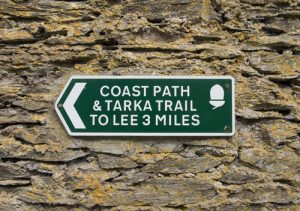
The Coast Path 4.5 miles walk to the ‘Torres’ is popular with tourists
A few of the recommended things to see and do in and around Ilfracombe are:
- St Nicholas Chapel – perched on Lantern Hill, it serves as both a chapel and a lighthouse. At 650 years old, it’s the oldest working lighthouse in the country. It has emitted a light source of one form or another since the Middle Ages, guiding ships to the harbour. There’s a steep hill to climb to get there but the views are worth the effort. Admission is free!
- Chambercombe Manor – dates from the 11th century and was originally owned by the Norman Champernon family. The infamous haunted manor has a reputation of being one of the scariest houses in the country. If your feeling brave enough, you can check out the hauntings for yourself, by staying as an overnight guest. There are usually volunteer guides around to share their local knowledge of the manor’s history and it’s ghosts.
- South West Coast Path Walk – is England’s longest footpath. The 4.5 mile (7 km) route between Ilfracombe and the ‘Torrs’ (aka ‘The Seven Hills’), runs through a long, wooded valley. The route is rugged, steep and challenging, in places, but also well maintained. There are some spectacular views of the North Devon coastline and you’ll also find few small cafes spread along the route.
- Tunnels Beaches – are four hand carved rock tunnels, dating from the 1820’s, that provide the only access to a stretch of secluded beach and coastline. It also a popular venue for weddings.
- Watermouth Castle & Theme Park – is a mid-19th century grand country house built in the style of a mock castle. The house is a Grade II listed building, set in fine gardens, has relics and artefacts on display that it might have had in Victorian times, including suits of armour and sporting trophies. However, within the grounds there is also family theme park, complete with the expected range of rides and attractions.
- Ilfracombe Sea Safari – is a sea trip along the North Devon coast and on to Lundy Island taken by a powerful ‘Humber’ rigid inflatable boat (RIB). You’re quite likely to encounter dolphins, seals and porpoises, so there’ll be plenty of good photo opportunities.
- Active Escape – is located just a few miles from Ilfracombe at Watermouth. The adventure centre provides opportunities to partake in a range of watersports, including coasteering, coastal rafting and stand-up paddleboarding, as well as other adventure challenges. The centre can cater for family units through to large parties.
- The Quayside – dominating the habour area is the 20-m high, Damien Hirst statue ‘Verity’, a pregnant woman holding a sword aloft. The name is derived from the Latin word for ‘truth’. However, there’s also plenty more to see and do around the picturesque quayside.
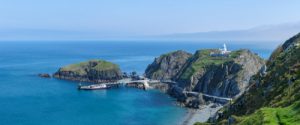
Lundy Island 23 miles off the coast of North Devon is a popular place to visit#
Where to stay?
There is both a good amount and varied range of accommodation types in and around Ilfracombe. A broad indication of types and corresponding prices, for 2 adults sharing is:
B & B/Guesthouse £60 – 90
Hotel: £90 – 150
Luxury Hotel: £150 – 200
Moving to Ilfracombe?
Thinking of moving to Ilfracombe? The average property price in the Ilfracombe area for July 2020 stood at approximately £240,500. This represents a fall of almost 6 % on the average price paid in the last 12 months. In terms of property types, flats were selling for an average of £197,300, terraced houses for £201,000 and semi-detached for £248,500.
Photo credits to: +S Buckley/*tviolet/#Steve Heap/Shutterstock.com

